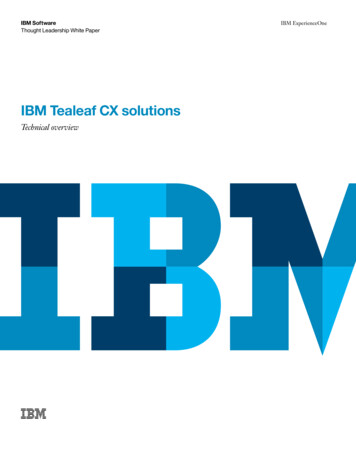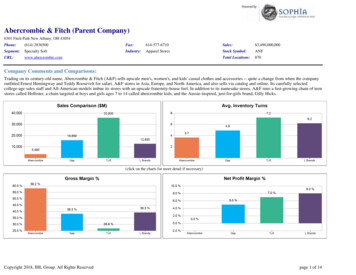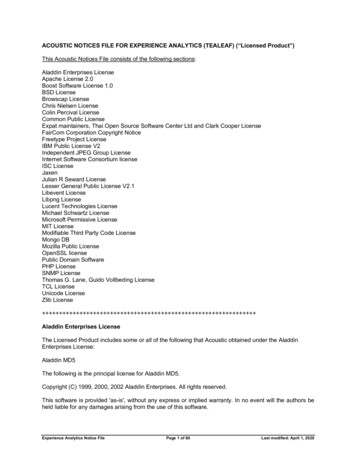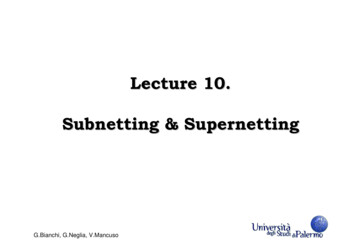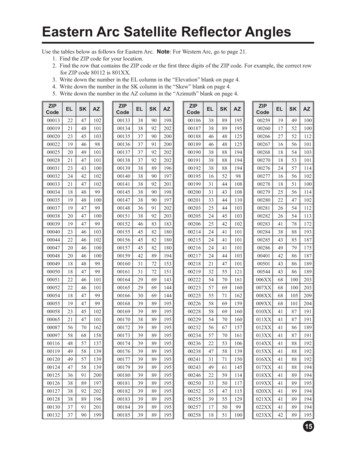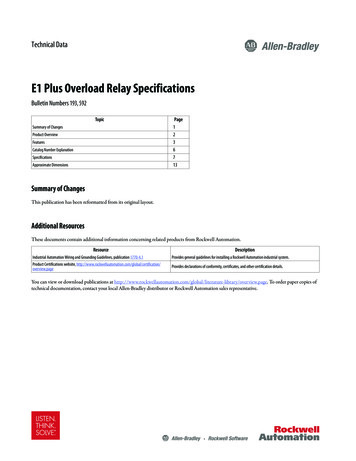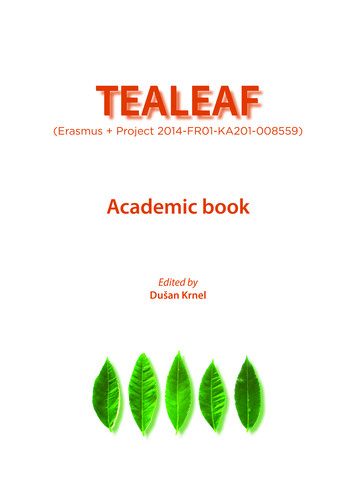
Transcription
TEALEAF(Erasmus Project 2014-FR01-KA201-008559)Academic bookEdited byDušan Krnel
University of LjubljanaFaculty of EducationTEALEAF(Erasmus Project 2014-FR01-KA201-008559)Academic bookEdited byDušan KrnelLjubljana, 2017
TEALEAF – Academic book(Erasmus Project 2014-FR01-KA201-008559)Edited byReviewsPublished byFor publishersCover designLayoutAvailable at (URL)Dušan KrnelBarbara Bajd in Zoran BosnićUniversity of Ljubljana, Faculty of EducationJanez Vogrinc, deanDušan KrnelIgor Zalozba/epublikacije/TEALEAF 2017.pdf authors, 2017The project is financed by the European Union.This publication reflects the views only of the author, and the ERASMUS Agency and the Commissioncannot be held responsible for any use which may be made of the information contained therein.Kataložni zapis o publikaciji (CIP) pripravili v Narodni inuniverzitetni knjižnici v LjubljaniCOBISS.SI-ID 291626240ISBN 978-961-253-213-0 (pdf)
3CONTENTSPreface51Participating Institutions72Biodiversity and Digital Technologies in SchoolGregor Torkar3Apps and Biodiversity: Teachers Using Digital Learningto Teach about BiodiversityTom McCloughlin, Hugh Gash, Gregor Torkar4Existing Apps for Learning Biodiversity at SchoolsZdeňka Chocholoušková, Penny Humbly5Teachers’ Digital Competencies Development through Appsand Digitals Stories about BiodiversityIrena Nančovska Šerbec, Gregor Torkar, Dušan Krnel496"We had plenty of ideas and it was very interesting to exchange" –Tealeaf Teachers as a Community of PracticeSandra Austin637Using a Concept Map to Evaluate Pedagogical Value of a Serious Gameabout Plant EcologyGregor Torkar, Dušan Krnel, Zdeňka Chocholoušková, Penny Humby77132535
4TEALEAF / Academic book
5PREFACEThis book is one of the output-results of a collaborative research effort between researchers from thevarious partner institutions involved in the project. The aim of the project was to improve both learningand teaching related to biodiversity using serious games in classrooms (so-called apps) and to highlightthe need to think critically about the pedagogical facets and potential of apps. One specific aspect of theproject was the inclusion of a number of science teachers and students in the process. These two groupsserved as a source of data that was collected over the course of various activities. An analysis of this iterative process is published as a body of research papers herein.We hope this book represents a useful new approach to using apps in teaching and learning about biodiversity and in the teaching of science in general.We thank the groups of teachers from the five participating countries who agreed to take part in thiscollaboration. Thanks to colleagues who joined the research part of the project; and finally, we thank ourcolleagues from Laval for their highly supportive and democratic leadership of the project.Dušan Krnel
6TEALEAF / Academic book
71PARTICIPATING INSTITUTIONSDirection Diocésaine de l’Enseignement Catholique (DDEC) de la MayenneThe Direction Diocésaine de l’Enseignement Catholique (DDEC) de la Mayenne represents a large network of private schools that is part of the French public school system of education (under contract withthe Ministry of education). It is situated in the west of France in LAVAL.1500 teachers and 22780 pupils distributed in 134 schools: 11000 pupils in 101 pre-primary and primary schools6760 students in 14 secondary schools (colleges)5020 students in 11 high schools which offer courses in the fields of general education, technological andvocational education.4 strategic aims: Promote an educational climate dedicated to the person.Innovation to enable children and young people to progress.Introduce and support changes.Propose roads of Christian faith.Direction of Catholic Education in Mayenne has got several missions: To identify schools network’s needs of in fields of organization, recruitment, education, ICT, pastoral,pedagogy, management and to propose appropriate answers.To organize the recruitment of both head teachers and teachers and their replacement in case of absence.To make the link with the territorial representatives of the government within the framework of the contract with the educational public ministry (inspectors, regional education authorities, regional council,mayors association, etc.).To participate in initial teachers training in partnership with UCO (Université Catholique de l’Ouest).To propose in-service training for teachers, head teachers and non teaching staff in connection withtraining institutes.To provide teaching teams with e.g. organizing research-action workshops, seminars, etc.To watch the development and evolution of schools network in dialogue with ministry of education.To take care of the maintenance and development of schools buildings.To provide schools with digital working environments.To provide schools with suitable conditions for students with specific needs.Staff involved in the project: Marie-Aline Vivier-Laroche, Marie-Line Guesdon, Mickael Gac, ChristineMortoireUniversity of AlmeriaThe University of Almería (UAL) (http://www.ual.es) is a non-profit organization which was created bythe Andalusian Parliament in 1993. That was the beginning of a crucial period for the construction of theUniversity and the planning of the future development. Today it is one of the youngest and most dynamic
8TEALEAF / Academic bookuniversities of Spain with about 14,000 students (and almost 600 doctorate students), more than 800lecturers, organized in 13 departments and in more than 100 research groups, and more than 500 administrative staff. The UAL participates in various mobility programmes such as: ERASMUS, ISEP, Pima,Anuies and it has more than 650 students from all over the world.The main purpose of the University of Almeria is to adapt its services to the new demands of the societyin order to reach the quality and efficiency objectives in teaching, research and management. Nowadaysthe University of Almería offers the students the possibility of studying 34 degrees courses, 30 doctoralprogrammes, 57 official masters’ programmes and 15 non-official masters’ programmes. It also proud ofits modern facilities among which we can find its lecture theatres buildings, an auditorium, an indoorsport centre with a swimming pool and outdoors sport tracks and tennis courts. Apart from the degreecourses, the student can avail of a broad range of courses designed by the University, such as specialistcourses, expert courses, master’s programmes, etc., and a large offer of cultural and sport activities, whichintend to satisfy the academic and extra academic demands, coming not only from the university community but from the society in general. There are more than 20 summer courses every year, which arefollowed by more than 1,300 students. The University of Almería has a solid commitment with researchand investigation, featuring in the third position in the Andalusia scientific production ranking, with 300research contracts signed with companies, 70 patents registered and 700 published works.Staff involved in the project: Rubén Martinez, José Luis Ruiz RealDublin City UniversityDublin City University (http://www.dcu.ie), or Ollscoil Chathair Bhaile Átha Cliath in Irish, was foundedin 1981 and comprises over 17,000 students including over 2700 postgraduate students, of whom over 700are research students. The University is consistently ranked among the top young universities globally,appearing in the QS Top 50 under 50, and Times Higher (THE) Top 100 under 50. DCU incorporatedSt. Patrick’s College of Education, The Church of Ireland College of Education, Mater Dei Institute ofReligious Studies and Education, and All Hallows College in 2016, all founded in the 19th century astraining colleges.Dublin City University: Promotes world class excellence in research and innovation in its core areas.Focuses on research and innovation which can make a difference to problems that matter to industryand society.Provides a business-friendly environment to multiply the effects of its activities in research andinnovation.DCU’s strategic plan “Transforming Lives and Societies”. DCU’s mission is to transform lives and societies through education, research and innovation. DCU’s Core Principles capture the distinctive essenceof DCU: Transformation, Enterprise, Translation and Engagement. This is accomplished by discovering,analyzing, expanding, and disseminating knowledge, by developing creative and critical thinking and byfostering skills and learning.Dublin City University aims to transform lives and societies through education, research and innovation. In order to achieve this, DCU has arranged much of its research activities to address major areas ofsocietal and economic needs – health, information technology, sustainability and resilience. To ensurethat DCU research increases its real-world impact, we are focusing on priority areas where DCU hasrecognized strengths and where society is facing significant challenges. These areas form four research
Participating Institutionsand enterprise hubs: health technologies, and the healthy and aging society,information technology and the digital society,sustainable economies and societies,democratic and secure societies,The resources and expertise in the hubs will be reinforced by additional expertise in three cross-cuttingplatforms that provide support in key areas of science and technology, business processes and social sciences. In each hub, researchers from across our five faculties (DCU Institute of Education, Engineeringand Computing, Humanities and Social Sciences, Science and Health, and the DCU Business School)can work together to tackle problems in new ways and deliver innovations of benefit to society. Theresearchers will be supported by integrated administrative, communications and business developmentteams to make the most of resources and to engage effectively with external enterprises. Each hub andplatform will be guided by an academic director who will build on existing strengths and develop newactivities for future growth.A Science and Technology Enhancement Platform (STEP) will link key areas of science and technologyand allow us to make best use of our existing resources. It will enable DCU to develop infrastructure thatwill be critically important for future research in core science and engineering disciplines and in addressing several key societal challenges.The Societal Impact Platform will help to incorporate societal perspectives into our research and to increase public engagement. Dublin City University encourages researchers to consider six key aspects toenable a better alignment of their research with the values, needs and expectations of modern societies.These include: engagement, gender equality, science education, open access, ethics, and governance.Staff involved in the project: Thomas McCloughlin, Sandra Austin, Penny HumbyUniversity of LjubljanaThe University of Ljubljana implements and promotes basic, applied and developmental research and is pursuing excellence and the highest quality as well as the highest ethical criteria in all scientific fields and art. In these areas of national identity the University of Ljubljana specifically develops and promotes Slovenian scientific and professional terminology.Based on its own, Slovenian, and foreign research, the University of Ljubljana (UL) educates criticalthinking top scientists, artists and professionals qualified for leading sustainable development, takinginto account the tradition of the European Enlightenment and Humanism and with regard to humanrights. Special attention is dedicated to developing talents.The UL encourages interdisciplinary and multidisciplinary study, exchanges results of achievements inscience and art with other universities and scientific research institutions, thus contributing to the Slovenian and world knowledge treasury as well contributing to the transfer of these achievements amongthe students and other users.The UL cooperates with organizations from economy and service in public and private sector, with stateorganizations, local communities, and civil society. With this cooperation accelerates the use of own research and educational achievements and contributes to the social development. With active responsesto events in the environment represents the critical conscience of the society.9
10TEALEAF / Academic bookThe Faculty of Education of the University of Ljubljana educates and trains teachers and other professional workers in the field of education. We train all kinds of professionals, from preschool and primaryteachers to teachers who are specialists in teaching two subjects or subject areas in primary school, aswell as in certain secondary schools. The advantage that graduates from the Faculty of Education havelies precisely in having been trained for at least two subject areas, which increases their employment opportunities as well as responding to the needs of school practice.In addition, to the traditional teachers’ programmes, the Faculty of Education of the University of Ljubljana is the only institution in Slovenia that trains specialists for inclusive education and the educationof children and young people with special needs. It does this through the study programmes of socialpedagogy and special and rehabilitation pedagogy, covering the entire spectrum of special needs: frombehavioural and social difficulties to all kinds of impairments (vision, hearing, speech, movement) andlearning difficulties.Fifty years of evolution of Faculty of Education could be divided into three parts: (1) period of HigherEducation School (1947-1964), (2) period of Education Academy (1964 - 1987), and (3) period of University study programmes (since 1987).The faculty executes seven first cycle study programmes (BA/BSc) and twelve second cycle study programmes (MA/MSc). In the 2009/10 academic year, we commenced the execution of a new doctoralstudy programme entitled Teacher Education and Educational Sciences, which is divided into the twoscientific areas of the programme title: Teacher Education and Educational Sciences.The Faculty of Education regularly organises supplementary professional education, as well as pedagogical andragogical (adult) education. Particularly in recent years, scientific-research and artistic work havebeen strengthened at the Faculty of Education, although many teachers have also worked in these areaspreviously. A range of teachers have successfully established themselves at symposia and conferences inSlovenia and abroad, as well as been included in international research projects in which they collaboratewith similar universities/faculties in Slovenia and abroad. The primary research undertaken at the Faculty of Education of the University of Ljubljana is from the areas of educational sciences, natural sciences,social sciences and the humanities.At the Faculty of Education we are aware of the importance of the pedagogical profession and endeavourto ensure the quality of our educational work in all of its facets. Our strategy is to become a leading university in teacher education that provides the highest quality research and teaching, and engages locallyand internationally on the issues and debates of the current issues in today’s education contexts. Drivenby research in various educational disciplines, and stimulating learning, the internationally oriented university informs and changes their practice and thinking constantly.Staff involved in the project: Irena Nančovska Šerbec, Gregor Torkar, Dušan KrnelUniversity of West BohemiaThe University of West Bohemia in Pilsen (UWB) is the only public institution of higher educationbased in the Pilsen Region. Currently, the University has nine faculties consisting of 57 departmentsand 2 institutes of higher education. 13 118 students studying at the University can choose from a wideof range of undergraduate, postgraduate and doctoral study programs, the choice of form of study, i.e. afull-time, part-time or combined form, being a matter of course.The educational activities at the University of West Bohemia in Pilsen include life-long learning programs
Participating Institutionsfor the general public in the form of lectures, courses and comprehensive training programs, includingthe popular Third-Age University. In addition to its educational activities, the University is also an important centre of Research and Development, with massive investment in University development andconstruction activities on the University campus. The University campus, in particular, is currently undergoing very dynamic changes – with an annex to the University Library building, and new buildingsof the European Centre of Excellence NTIS and the Centre of Technical and Natural Science Educationand Research literally growing in front of our eyes. These investments are the largest in the history ofthe University of West Bohemia in Pilsen and, in the future, they will form a very promising base foreven more intensive co-operation with universities all over the world not only in the field of Researchand Development, but also in student mobilities. The newly constructed research centres will definitelystrengthen the links between the University and businesses and other institutions. This is also one of thereasons why UWB scientists involved in various disciplines, as well as UWB students, win prestigiousawards for their activities every year.The University of West Bohemia in Pilsen has a significant position among universities in both the CzechRepublic and Europe. This is documented by the ECTS Label (European Credit Transfer and Accumulation System designation) the University received in late 2012, which confirms that the study environmentat the University of West Bohemia in Pilsen fully matches European standards. As a result, the Universityhas officially entered the area of European tertiary education.The Faculty of Education of UWB is the oldest and largest faculty of the University of West Bohemia inPilsen. It was established as a branch of the Faculty of Education of Charles University in Prague. It wassolemnly opened on 14 November 1948.In 1990, the Faculty of Education became part of the newly formed University of West Bohemia. Now,around 2,000 students are studying at FPE in many types of study programs and fields. The main objective and mission of FPE in Pilsen is to provide quality education and training for teachers of all types ofschools (kindergarten, primary school, secondary school and high school).The Faculty organizes a wide range of complementary and extension courses in the framework of Lifelong Learning.The Faculty is trying to compete in all three roles which, as part of the university, it has: in education,research and socio-cultural areas. Its primary mission is, however, training teachers, which plays (andwill play) a key role in the process of enhancing the education and culture of the nation.Staff involved in the project: Zdeňka Chocholoušková, Thomas Přibáň11
12TEALEAF / Academic book
132BIODIVERSITY AND DIGITAL TECHNOLOGIES IN SCHOOLGregor TorkarUniversity of Ljubljana, Faculty of Educationgregor.torkar@pef.uni-lj.siAbstractThis article describes the concept of biodiversity in the school context and emphasizes what students can learn about biodiversity concepts using digital technologies. Teaching about biodiversityand its conservation could be an effective means of communicating the significance of various species and ecosystems and people’s dependence on ecological support systems. A three-stage nestedmodel with four main guidelines for teaching biodiversity is outlined, recommending teachingfrom the species to genetic level, from the local to global (natural, social) environment, from directto symbolic experiences, and from the affective to the ethical level. In addition, progress in digitaltechnologies, particularly m-learning, enables students to gain experience about biodiversity usingreal-world and digital-world learning resources.Keywords: biodiversity, education, teaching, guidelines, school, digital technologiesIntroductionLife on Earth most likely began some 3.5 billion years ago. Large-scale extinction of species has occurredseveral times since then due to natural factors such as major volcanic eruptions and comet strikes. Thelargest extinctions usually mark the end or the beginning of geological periods. The most recent was theCretaceous-Tertiary large-scale extinction of over 75% of animal and plant species (Raup & Sepkoski,1982). Some scholars also include the period starting 500,000 years ago among the periods of minorextinctions that were caused by human activity.There is a global trend of decreasing biodiversity resulting from human society’s transformation from anecosystem into a biosphere (Kryštufek, 1999; Primack, 2010; Sinclair et al., 2005). At the same time, thereis an increasing awareness of the significance of biodiversity conservation for the survival of humankind(MEA, 2005). According to reports on the current state of biodiversity, the most negative impact onbiodiversity is caused by the following human activities: the degradation and fragmentation of species’habitats, introduction of invasive alien species, pollution, excessive use of natural resources, and climatechange (Hamble & Canney, 2013). Biodiversity has become a priority of the UN Decade of Educationfor Sustainable Development 2005–2014 (UNESCO, 2005). Governments and other stakeholders haveagreed to integrate biodiversity into all levels of education (UNEP/CBD/COP/8/14, 2006). EU memberstates have defined the establishment of the Natura 2000 network and its effective management as akey objective for halting the decrease in biodiversity. The Natura 2000 network includes over a third ofSlovenia’s territory, which is important for the conservation of the species and habitats specified in theDirective on the Conservation of Wild Birds (1979) and the Directive on the Conservation of NaturalHabitats and of Wild Fauna and Flora (1992), as well as endemic and nationally endangered species. Thegreatest current achievement of biodiversity conservation efforts has been the UN decision to declare the2011–2020 period the United Nations Decade on Biodiversity, the main goal of which is to significantlyreduce global biodiversity loss (UNGA, 2011).The article continues by defining the term biodiversity, after which it discusses in detail the significanceof incorporating this topic in educational processes, and presents the relevant research findings and
14TEALEAF / Academic bookguidelines for teaching biodiversity. It concludes by highlighting the research findings on the role oftechnologies in teaching biodiversity.Biodiversity and What It MeansWilson was the first to use the term biodiversity in his book of the same name (Biodiversity, 1988), eventhough it was actually coined by Rosen that same year (Lindemann-Matthies et al., 2011). Anko (2000)explains that the term is by no means new in the natural sciences. It is believed to have become fashionable after the UN Conference on Environment and Development, which took place in Rio de Janeiro in1992. Biodiversity conservation became an important value, which was recognized as a global interest by150 countries in 1992, leading to the adoption of the Convention on Biological Diversity.Levels of BiodiversityBiodiversity refers to the diversity of life on Earth, which continues to change and adapt due to ecologicaland evolutionary processes. In the most simplified terms, biodiversity is defined as genetic, species, andecosystem diversity, which also agrees with the definition in the Convention on Biological Diversity. Ina narrow sense, the concept of biodiversity denotes the variability among organisms in a specific region.Biodiversity implies a perfect diversity of living organisms at the level of (a) genomes, (b) individuals (indifferent life strategies), (c) populations, different ecotypes, and subspecies, (d) species (species biodiversity), communities, ecosystems, and different reactions of a community as a whole to the environment,and (e) biomes (Tome, 2006). Individual levels of biodiversity are presented in detail below (Primack,2010; Sinclair et al., 2005; Tome, 2006).Diversity within SpeciesA genome is the genetic material of an individual organism. The next level is the level of an individualrepresented by any specimen of a particular species that has unique abilities conditioned by its geneticmakeup and the environment. The highest level of species diversity is the population and subspecieslevel. A population consists of the entire group of organisms of a given species that lives in a geographically defined location at a specific time. Animal species can be further divided into subspecies, and plantsand fungi into even smaller classification categories.Diversity among SpeciesIt is not easy to provide a definition of species. At best, it can be defined as a group of organisms that canreproduce among themselves, have fertile offspring, and are reproductively isolated from other species.Diversity among species can be defined as wealth in species and species diversity, in which wealth inspecies refers to the number of different species in a community, and species diversity denotes wealth inspecies taking into account the abundance of an individual species (i.e., uniform representation of species) in a community.Diversity of EcosystemsDiversity of ecosystems is reflected at the level of communities, ecosystems, and biomes. The level of acommunity comprises all interactions between the populations of species that occupy a specific locationat a specific time. The level of an ecosystem refers to the system of interconnected elements formed byinteractions between a community and the nonliving environment. The level of a biome is represented bythe community of the fauna and flora species typical of a specific geographical region.Landscape DiversityEspecially in the past two decades, views have been presented explaining that effective biodiversity conservation also demands taking into account the landscape level of biodiversity (e.g., Forman, 1995). Allorganisms are linked to their living environment, which they participate in shaping and changing in one
Biodiversity and Digital Technologies in Schoolway or another. In many environments, humans are a highly influential factor or the key species (Holling,1992, cited in Farina, 1995). In 2000, the European Landscape Convention was adopted in Florence. Itsobjectives include landscape protection, management, and planning, and raising public awareness of theimportance of landscapes.The Significance of Biodiversity for HumankindEnvironmental protection focuses on the conservation of ecosystems, habitats, and species, highlightingthe intrinsic value of nature – that is, the value of nature in and of itself regardless of the benefits andvalue ascribed to it by humans. A variety of ecological, economic, ethical, spiritual, and cultural valuesare related to biodiversity and its conservation (Callicott, Crowder, & Mumford, 1999). The variety ofvalues ascribed to biodiversity also indicates this concept’s importance and controversy, which presentsa great challenge to professionals in both nature conservation (Trombulack et al., 2004) and education(Gayford, 2000; Van Weelie & Wals, 2002). Fisher et al. (2009) argue that long ago different peoplesunderstood and were aware of the natural conditions of ecosystems. Approximately 10,000 years ago,people were aware of the importance of the services that ecosystems provided to them because theyused them in agriculture to increase productivity. They knew that deforestation caused soil erosion andwater sources to dry out, which had a negative impact on extracting resources from the ecosystems. Inhis analysis of the work Die Ehre deß Hertzogthums Crain (The Glory of the Duchy of Carniola), Svetičič(2015) reports that the author Johann Weikhard von Valvasor comprehensively identified the production,ecological, and social functions of forests, which testifies to his broad understanding of forests. However,because Valvasor stood out intellectually in the environment of his time, his awareness cannot be equatedwith how society in general in the second half of the 17th century understood forests. The functioningof ecosystems as service providers was first described in the 1970 Report of the Study of Critical Environmental Problems (Fisher, 2009). Over the years, the terms referring to ecosystem services continued tochange until Ehrlich and Ehrlich introduced the term ecosystem services in 1981 (Fisher, 2009). Ecosystem services were defined as various direct or indirect benefits of ecosystem processes (Costanza et al.,1997; Daily, 1997). Alarming environmental changes stimulated scientists to start systematically publiclypromoting the services that biodiversity also provides to humans. However, even though ecosystemsprovide a multitude of various services, these are not considered in political and economic decisionsbecause their market value is not specified or, in other words, it is difficult to specify and measure (Ninan& Inoue, 2013).The most frequently used classification of ecosystem services is the one provided in the MillenniumEcosystem Assessment (MEA), which divides them into regulating, provisioning, cultural, and supporting services (MEA, 2005). Provisioning services are the goods produced or supplied by ecosystems (e.g.,food, fiber, fuel, various medicines, genetic resources, and drinking water). Regulating ecosystem services refer to the benefits obtained from the ecosystems’ regulating ability (e.g., air quality, climate, water,disease, and erosion regulation, pollination, etc.). Cultural ecosystem services comprise the nonmaterialbenefits obtained
TEALEAF (Erasmus Project 2014-FR01-KA201-008559) Academic book Edited by Dušan Krnel. TEALEAF (Erasmus Project 2014-FR01-KA201-008559) Academic book Ljubljana, 2017 Edited by Dušan Krnel University of Ljubljana Faculty of Education. Kataložni zapis o publikaciji (CIP) pripravili v Narodni in


